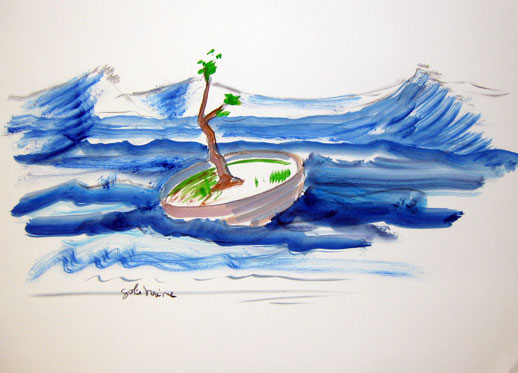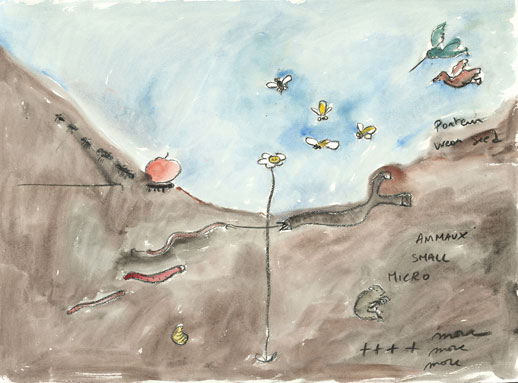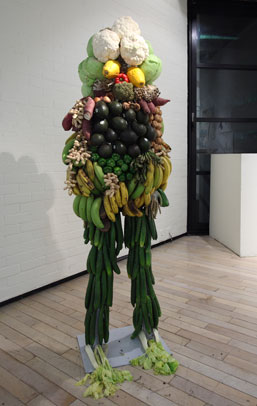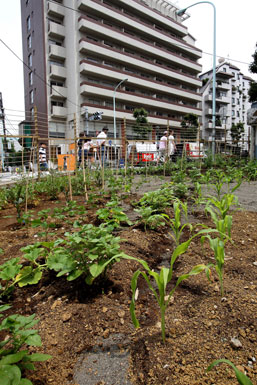Urban Gardening Guerilla Sows Flash Greenery
Fabrice Hyber is an artist-cum-landscape provocateur. He’s trying to “seed and grow” plants all over Tokyo, starting with the Watari Museum of Contemporary Art. The third floor has been turned into a temporary countryside installation, choked with dry grass and tangles of parched reeds. Even more arresting than the sight of this unruly infestation, however, is the smell and feel of it – that earthiness, and those hairy tufts, the tactile experience of wandering down a dirt road in rural France.

Transplanting seeds into the sterile concrete jungle of Tokyo. Will they grow? Hyber is hoping to spread this greenery by way of contagion. As an initial gambit, he’s taken to the streets around the museum and wedged little vegetable plots around the design and furniture stores, boutiques and disused lots that make up an average section of trendy Tokyo real estate. After that, it’s up to us to follow his example, to scatter ourselves — as well as the packet of seeds that Hyber has included with the exhibition leaflet — and pollinate the city with rogue greenery.

To inspire us, Hyber has placed transparent plastic boxes of bees, earthworms and flies on the fourth floor, urging us to observe their movements and maybe to replicate them in negotiations with our own environment. The transparent beehive stands out for being connected to a gallery window via a tube, through which the bees come and go as they please — this exhibit is not an isolated objet but a nexus of ongoing, organic activity. Here, we are reminded of how bees function with a communal hive mentality, how earthworms decompose garbage and recycle nutrients, how flies transport all sorts of things (including pathogens). These insects perform by instinct what we labor to accomplish in our resource-rich, circulation-poor society. Will more seeds and plants help? Will they contribute to cleaning the air, shading us from the sun, and buttressing the soil from erosion?
Like a flash mob impresario or a Situationist prankster, Hyber knows the limitations of exhibiting only within the closed indoor space of a museum. He’s already temporarily invaded the museum with insect communities, wonders of cellular organization that follow certain natural trajectories and patterns of flight and movement, a dynamic symphony. While the insects infiltrate the museum, the art has long left the building. Hyber has taken his main installations outside, setting up little enclosures of “flash” greenery and urging us to do the same. In doing so, he reverts back to the urban space of the city, calling attention to the living ecologies that make up both the garden plot and the urban jungle.


These ecologies are also visualized in Hyber’s drawings and figures displayed on the second floor — sketches of weather processes and their effect on farming, plant and insect interactions in soil and leaf litter communities, diagrams showing how winds navigate our cities. Hyber is concerned that the spectacle of these natural processes is disappearing from our cities, including their distinct textures, smells and sensations. Even when a city has been spruced up and greened, it’s mostly with ornamental plants that have been shaped and pruned, whose function has been somewhat neutered. In comparison, there is a harvest to be reaped by planting vegetables, and an edible one at that. With these pet plots of edible greenery, Hyber takes up the food performance art of people like Rikrit Tiravanija, acting as a benevolent garden gnome working quietly to surprise you with a generous bounty. Walking through Aoyama this summer, more than a few people will have been surprised to discover outbreaks of eggplants by the side of the road.
In another city, this vegetal disruption might be perfectly delightful to stumble upon, but as it stands, Tokyo is already choked by spontaneous outcroppings of other kinds: fifteen-storey construction “happenings” that appear out of nowhere, and conversely, other buildings that simply un-happen overnight. Shops and houses get weeded out of the mix, crumble, become altered, refurbished. In this city, greenery is already guerilla by definition: just look at all the compact “landscapes” of potted plants improvised to fit into the typically narrow frontage of a Tokyo housing lot. With little legitimate space to grow, plants are forced to huddle in the crevices between buildings (that are themselves made to squeeze in between other buildings). Architecture seems to be reduced to the same weedy sprouting, seeding and growing as soon as others uproot.
It looks like Hyber is fighting a losing battle to reclaim the city for greenery, but maybe that’s precisely what makes this exhibition especially poignant. He visualizes these warring ecologies, both urban and vegetal, and also highlights nature’s more elegant and efficient operations. Maybe this will help to redress the balance between them, and stave off the continued annexation of Tokyo by those blooming fields of concrete. These plants are going to need all the help they can get.
Darryl Jingwen Wee
Darryl Jingwen Wee



